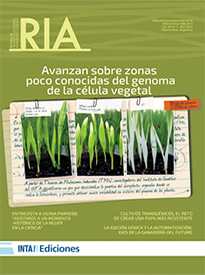Ver ítem
- xmlui.general.dspace_homeDirección Nacional y DNAsSistemas de Información, Comunicación y CalidadGerencia de Comunicación e Imagen InstitucionalArtículos científicosxmlui.ArtifactBrowser.ItemViewer.trail
- Inicio
- Dirección Nacional y DNAs
- Sistemas de Información, Comunicación y Calidad
- Gerencia de Comunicación e Imagen Institucional
- Artículos científicos
- Ver ítem
Calidad de frutos y maduración en naranjo dulce ‘Valencia Late’ [Citrus sinensis (L) Osbeck] cv Limeira, sobre diferentes portainjertos
Resumen
Para responder a las exigencias de los mercados mundiales es necesario la búsqueda permanente de portainjertos que confieran calidad a los frutos y maduración anticipada. El objetivo de este trabajo fue caracterizar plantas de naranjo dulce ‘Valencia late’ injertadas sobre 17 portainjertos, según atributos de calidad de frutos y precocidad de la maduración e identificar grupos de similares características. En un diseño completamente aleatorizado con seis
[ver mas...]
Para responder a las exigencias de los mercados mundiales es necesario la búsqueda permanente de portainjertos que confieran calidad a los frutos y maduración anticipada. El objetivo de este trabajo fue caracterizar plantas de naranjo dulce ‘Valencia late’ injertadas sobre 17 portainjertos, según atributos de calidad de frutos y precocidad de la maduración e identificar grupos de similares características. En un diseño completamente aleatorizado con seis repeticiones, se probaron combinaciones de naranjo dulce ‘Valencia late’ con 17 portainjertos. Al momento de la cosecha se seleccionaron al azar 15 frutos y se determinaron las siguientes variables: DE, GC, PJ, SST y ATT %, también se calculó el IM. Mediante un análisis de componentes principales, gráfico biplot y análisis de la varianza multivariado se pudieron agrupar los 17 portainjertos estudiados en cuatro grupos de acuerdo con la anticipación en la maduración. El grupo que más anticipa la cosecha se caracterizó por tener frutos con altos IM y contenidos de SST y menor ATT %; el segundo presenta frutos con altos PJ y contenidos de SST y, pero también alta ATT %; el tercero contiene los frutos con los mayores GC, los menores valores de PJ, SST, ATT % y valores intermedios para IM y DE; el grupo de menor anticipación se caracterizó por frutos con mayor ATT %, menores valores de IM y DE y valores intermedios de las otras variables.
[Cerrar]
In order to respond the demands of world markets, the constantly searching of rootstocks is required. The aim of this study was to characterize plants of sweet orange ‘Valencia Late’ [Citrus sinensis (L.) Osbeck] grafted on 17 rootstocks in Entre Rios, Argentina, according to fruit quality and early harvest. In a completely randomized design with six replications, combinations of sweet orange ‘Valencia Late’ with 17 rootstocks were tested. At harvest
[ver mas...]
In order to respond the demands of world markets, the constantly searching of rootstocks is required. The aim of this study was to characterize plants of sweet orange ‘Valencia Late’ [Citrus sinensis (L.) Osbeck] grafted on 17 rootstocks in Entre Rios, Argentina, according to fruit quality and early harvest. In a completely randomized design with six replications, combinations of sweet orange ‘Valencia Late’ with 17 rootstocks were tested. At harvest time, on 15 randomly selected fruits, following variables: equatorial diameter, rind thickness, juice percentage, soluble solids and titratable acidity were determined, and maturity index was calculated.
By Principal Component Analysis, Biplot graphic, Multivariate Analysis of Variance, the 17 rootstocks studied were classified into four groups according with the early harvest. The earliest group was characterized by fruits with larger diameter, high maturity index and contents of total soluble solids and lower acidity; the second one present fruits with high percentages of juice and soluble solids content, but also higher titratable acidity; the third one contains fruits with the largest shell thicknesses, the lowest values of percentage of juice, total soluble solids and titratable acidity and intermediate values for maturity index and equatorial diameter; the last one is characterized by fruits with higher titratable acidity, lower values of index of maturity and equatorial diameter and intermediate values in other variables.
[Cerrar]

Autor
Chabbal, Marco Daniel;
Gimenez, Laura Itatí;
Mazza, Silvia Matilde;
Ramirez, M.D.J.;
Rodriguez, Víctor A.;
Fuente
RIA 45 (1) : 67-73 (Abril 2019)
Fecha
2019-04
Editorial
Ediciones INTA
ISSN
0325-8718
1669-2314
1669-2314
Formato
pdf
Tipo de documento
artículo
Palabras Claves
Derechos de acceso
Abierto
 Excepto donde se diga explicitamente, este item se publica bajo la siguiente descripción: Creative Commons Attribution-NonCommercial-ShareAlike 2.5 Unported (CC BY-NC-SA 2.5)
Excepto donde se diga explicitamente, este item se publica bajo la siguiente descripción: Creative Commons Attribution-NonCommercial-ShareAlike 2.5 Unported (CC BY-NC-SA 2.5)


